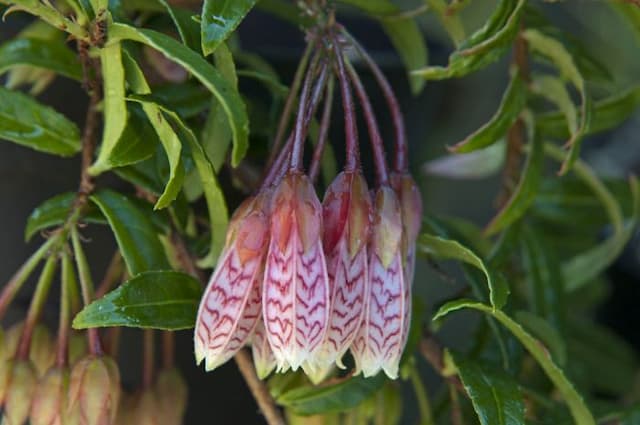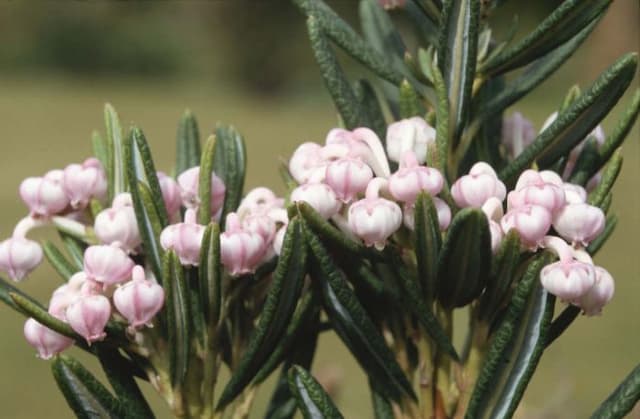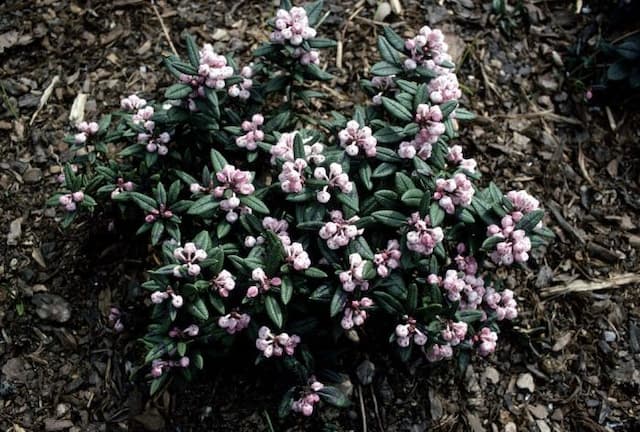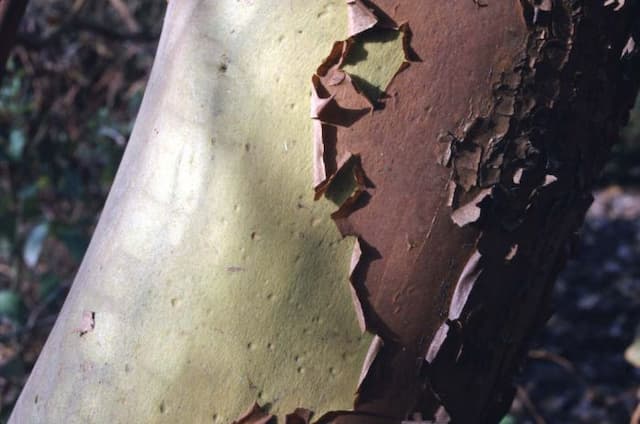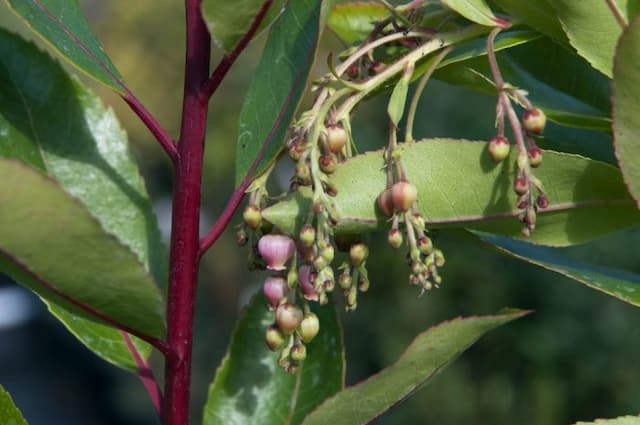Wintergreen Gaultheria procumbens











ABOUT
Gaultheria procumbens, commonly known as wintergreen, is a low-growing plant that is notable for its glossy, dark green leaves. These leaves are oval-shaped, come to a point at the end, and have a leathery texture. Wintergreen's evergreen foliage displays a striking contrast against snowy landscapes in the colder months, making it a popular ground cover in gardens. In the late spring to early summer, wintergreen bears delicate, bell-shaped flowers that are white or sometimes pale pink. These dainty blossoms hang from the stems in a nodding fashion, adding a subtle charm to the plant's appearance. As summer wanes, the plant produces bright red berries that persist through the winter. The berries are about the size of small pearls and provide a vibrant pop of color against the dark foliage. In addition to their visual appeal, the aromatic fruits and leaves emit a characteristic minty fragrance when crushed, which is reminiscent of the wintergreen scent used in various products. This combination of pretty leaves, enchanting flowers, and eye-catching berries, along with its aromatic qualities, make wintergreen an attractive plant for sensory gardens and picturesque landscapes.
About this plant
 Names
NamesFamily
Ericaceae.
Synonyms
Eastern Teaberry, Checkerberry, American Wintergreen, Boxberry.
Common names
Gaultheria procumbens var. angustifolia, Gaultheria procumbens var. leucocarpa, Gaultheria repens.
 Toxicity
ToxicityTo humans
Wintergreen is generally considered safe in small quantities, such as those used in flavorings and herbal remedies. However, the plant can be toxic if consumed in large amounts due to the presence of a chemical called methyl salicylate, which is similar to aspirin. Symptoms of wintergreen poisoning include stomach pain, confusion, headache, tinnitus, nausea, vomiting, diarrhea, rapid breathing, and can lead to more severe issues such as metabolic acidosis, convulsions, and respiratory failure if not promptly treated.
To pets
In pets, wintergreen can also be toxic if ingested. The methyl salicylate in the plant poses similar risks to pets as it does to humans, and pets are more likely to be poisoned due to their smaller body sizes and different metabolism. Symptoms of poisoning in pets include vomiting, diarrhea, weakness, difficulty breathing, stomach ulcers, kidney failure, and in severe cases, it can lead to central nervous system issues, seizures, and death. It is essential to seek veterinary care immediately if a pet ingests wintergreen.
 Characteristics
CharacteristicsLife cycle
Perennials
Foliage type
Evergreen
Color of leaves
Green
Flower color
White
Height
6 inches (15 cm)
Spread
2 feet (60 cm)
Plant type
Shrub
Hardiness zones
3
Native area
North America
Benefits
 General Benefits
General Benefits- Ornamental Appeal - Gaultheria procumbens, commonly known as Wintergreen, has attractive glossy green leaves and red berries, making it a popular ornamental plant.
- Ground Cover - Its low-growing, spreading habit makes it an effective ground cover for garden landscapes.
- Aromatic Foliage - The leaves of Wintergreen emit a pleasant, minty fragrance when crushed.
- Edible Berries - The bright red berries are edible, with a minty flavor, and can be used in small quantities to flavor foods and beverages.
- Winter Interest - Wintergreen provides year-round garden interest, especially in winter, when its red berries stand out against snow.
- Wildlife Habitat - The plant offers shelter and food for wildlife, especially birds, which feed on the berries.
- Low Maintenance - Wintergreen is relatively easy to care for and requires minimal maintenance once established.
- Shade Tolerant - It can thrive in shaded areas where other plants may struggle, making it versatile for various garden spots.
 Medical Properties
Medical Properties- Analgesic: Wintergreen oil, derived from Gaultheria procumbens, has been used for its pain-relieving effects.
- Anti-inflammatory: The plant contains compounds that can help reduce inflammation, particularly in topical applications.
- Topical treatment for arthritis: The methyl salicylate in wintergreen oil is used in some over-the-counter products for arthritis pain relief.
- Anti-rheumatic: Traditionally the plant has been used to treat rheumatic symptoms.
- Antispasmodic: It has been used to relieve muscle spasms.
- Aromatic therapy: The pleasant scent of wintergreen oil is used in aromatherapy.
 Air-purifying Qualities
Air-purifying QualitiesThis plant is not specifically known for air purifying qualities.
 Other Uses
Other Uses- As a flavoring agent in candies and gum, the wintergreen oil extracted from Gaultheria procumbens provides a refreshing, minty taste.
- In the production of smokeless tobacco products like snuff, the wintergreen aroma is sometimes used to impart its distinctive flavor.
- In some cultures, wintergreen leaves are incorporated into teas and infusions for their flavor, excluding any medicinal purposes.
- Wintergreen oil, through its scent, is employed in aromatherapy for creating a soothing and invigorating atmosphere.
- Essential oil from the wintergreen plant is often used in perfumery to add a woodsy, clean note to fragrance compositions.
- Wintergreen's essential oil acts as a natural insect repellent, helping to deter pests from gardens and outdoor areas.
- The berry-like fruits of wintergreen can be used as natural decorations in crafts and festive wreaths during the holiday season.
- Wintergreen plants are used in landscaping for their attractive ground cover and ability to thrive in shady areas.
- An infusion of wintergreen leaves can provide a natural dye for textile projects, yielding pale green to yellow hues.
- Wintergreen extract has been utilized as a flavoring component in specialty beer and other alcoholic beverages for a unique twist.
Interesting Facts
 Feng Shui
Feng ShuiThe Eastern Teaberry is not used in Feng Shui practice.
 Zodiac Sign Compitability
Zodiac Sign CompitabilityThe Eastern Teaberry is not used in astrology practice.
 Plant Symbolism
Plant Symbolism- Protection: Gaultheria procumbens, commonly known as Eastern Teaberry, is often associated with protection due to its hardy nature and its ability to thrive in harsh environments.
- Healing: With its medicinal properties and use in traditional remedies, the Eastern Teaberry symbolizes healing and the alleviation of pain.
- Purity: The bright red berries and evergreen leaves of the Eastern Teaberry convey a sense of purity and cleanliness, representing new beginnings and freshness.
- Peace: The plant is also linked with tranquility and peace, possibly due to its presence in serene forests, promoting a calming effect on those who encounter it.
- Good Luck: In some cultures, the Eastern Teaberry is carried or used in rituals to attract good luck and prosperity.
 Water
WaterFor the Wintergreen or Checkerberry, it is important to keep the soil consistently moist without waterlogging. Water the plant when the top inch of soil feels dry to the touch. Generally, watering once or twice a week should suffice, but this may vary depending on the humidity and temperature conditions of the environment. Each watering should provide enough water to soak the soil around the roots. As an estimate, this might mean using about 16 to 24 ounces of water for a medium-sized pot during each watering session.
 Light
LightThe Wintergreen plant prefers bright, indirect light or partial shade. It can tolerate some morning sun, but too much direct sunlight, especially in the afternoon, can scorch the leaves. A spot that receives filtered sunlight, such as behind a sheer curtain, or a location with dappled shade under larger plants, is ideal.
 Temperature
TemperatureWintergreen thrives in cooler temperatures, ideally between 60 and 70 degrees Fahrenheit, but can survive in temperatures as low as 0 degrees and as high as 80 degrees Fahrenheit. However, prolonged exposure outside of its ideal range can stress the plant. Ensure protection from extreme cold or heat to keep the plant healthy.
 Pruning
PruningPrune Wintergreen to maintain its shape and encourage bushier growth. Remove dead or damaged branches and trim leggy stems, ideally in the early spring before new growth begins. Pruning once a year is typically enough, but the plant can also be lightly trimmed throughout the year as needed.
 Cleaning
CleaningAs needed
 Soil
SoilWintergreen prefers acidic soil with pH ranging from 4.5 to 6, requiring a well-draining mix like a blend of peat moss, perlite, and pine bark. Enriching the mix with organic matter helps mimic its native forest floor habitat.
 Repotting
RepottingWintergreen does not need frequent repotting; it can be done every 2-3 years or when the plant shows signs of being root-bound.
 Humidity & Misting
Humidity & MistingWintergreen thrives best in moderate to high humidity levels; attempt to maintain humidity at around 50% for optimal growth conditions.
 Suitable locations
Suitable locationsIndoor
Keep Wintergreen in bright, indirect light and maintain high humidity.
Outdoor
Plant Wintergreen in partial shade with acidic, well-draining soil.
Hardiness zone
3-8 USDA
 Life cycle
Life cycleEastern Teaberry (Gaultheria procumbens) begins its life cycle as a seed, which germinates in spring after stratification through cold winter temperatures. The seedlings develop into small, evergreen shrubs with glossy, dark green leaves, reaching maturity in a few years. During the late spring or early summer, mature plants produce bell-shaped, white or pink flowers that are pollinated by bees and other insects. After pollination, the flowers develop into bright red berries by fall, which persist through winter, offering food for wildlife. Alongside sexual reproduction, Eastern Teaberry can propagate vegetatively via its spreading rhizomes, creating dense mats of growth. As a perennial, the plant goes through a dormancy period in winter, slowing down growth until warmer temperatures return in spring.
 Propogation
PropogationPropogation time
Spring-Early Summer
The most popular method of propagating Wintergreen (Gaultheria procumbens) is through semi-hardwood cuttings. This process involves taking cuttings that are partially matured, typically from late summer to early fall. You cut a 4 to 6-inch (10 to 15 centimeters) length of stem that has a few leaves attached, ensuring that the cut is made just below a leaf node, where the concentration of growth hormones is high. The cutting's lower leaves are removed, and the cut end is often dipped in a rooting hormone to encourage root development. Afterwards, the cutting is placed in a moist, well-draining potting mix and covered with a plastic bag to maintain high humidity. The cutting should then be kept in indirect sunlight until roots have developed, which usually takes several weeks. Once rooted, the new Wintergreen plant can be transplanted into the garden or an individual pot.
